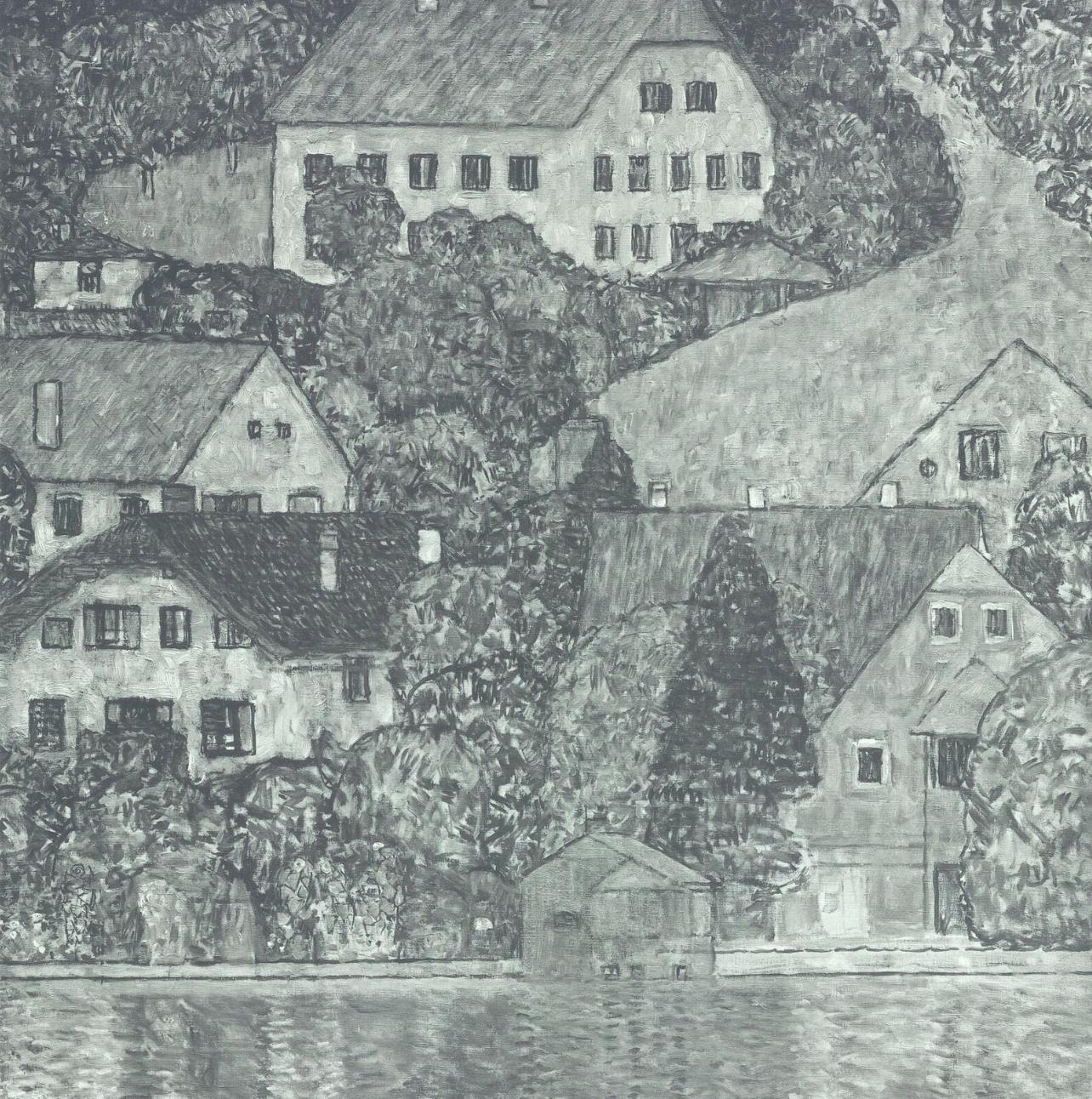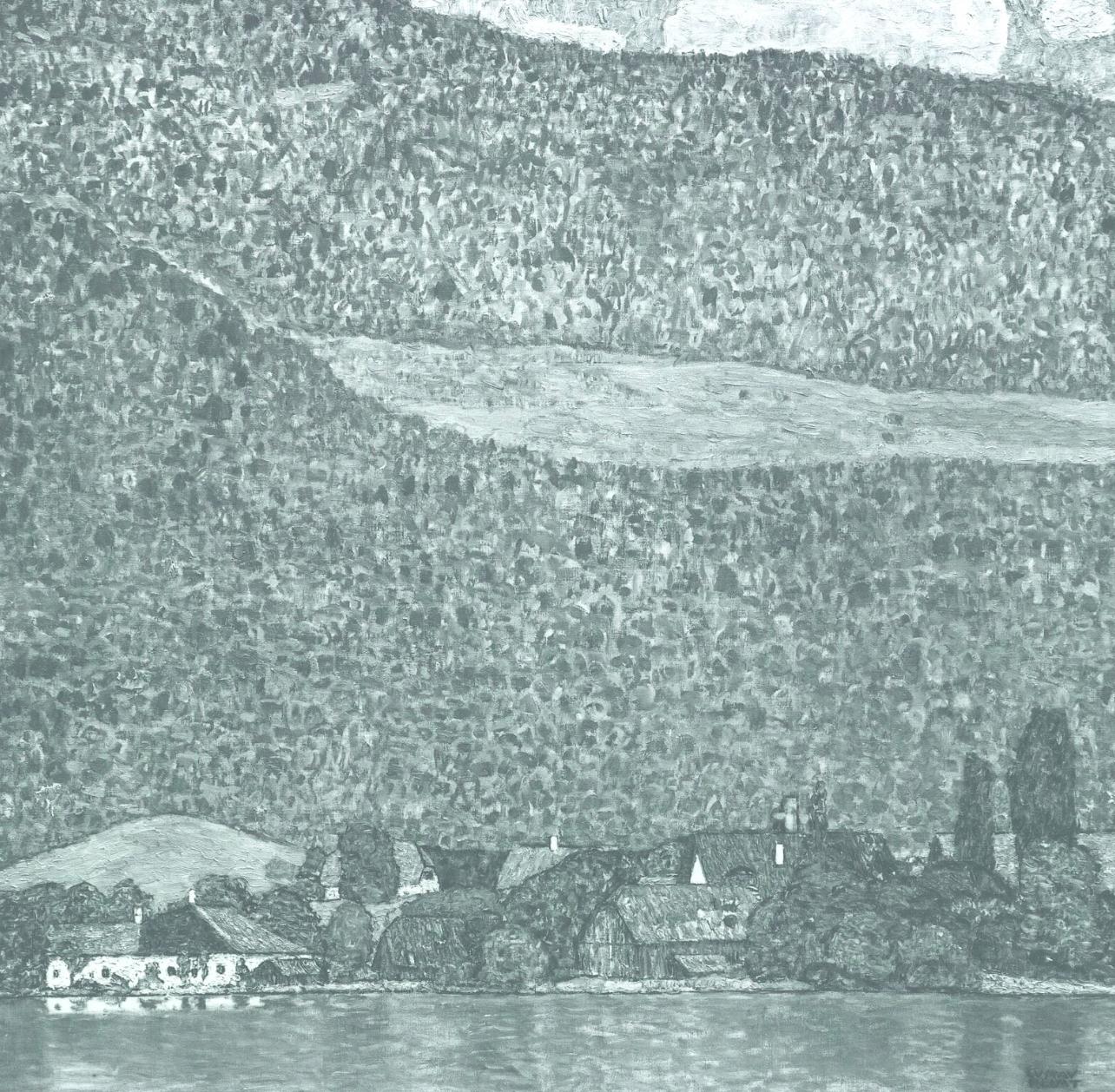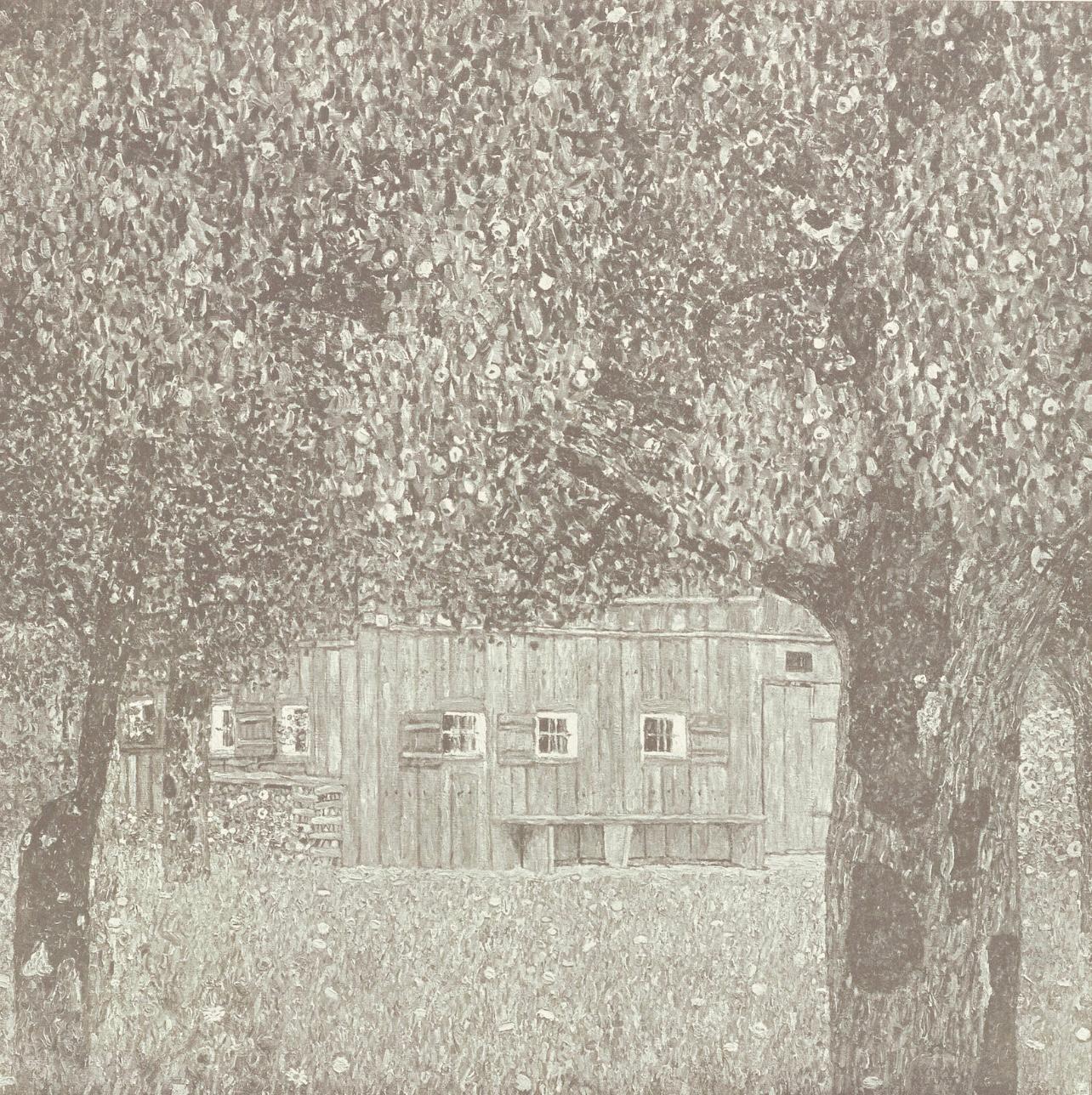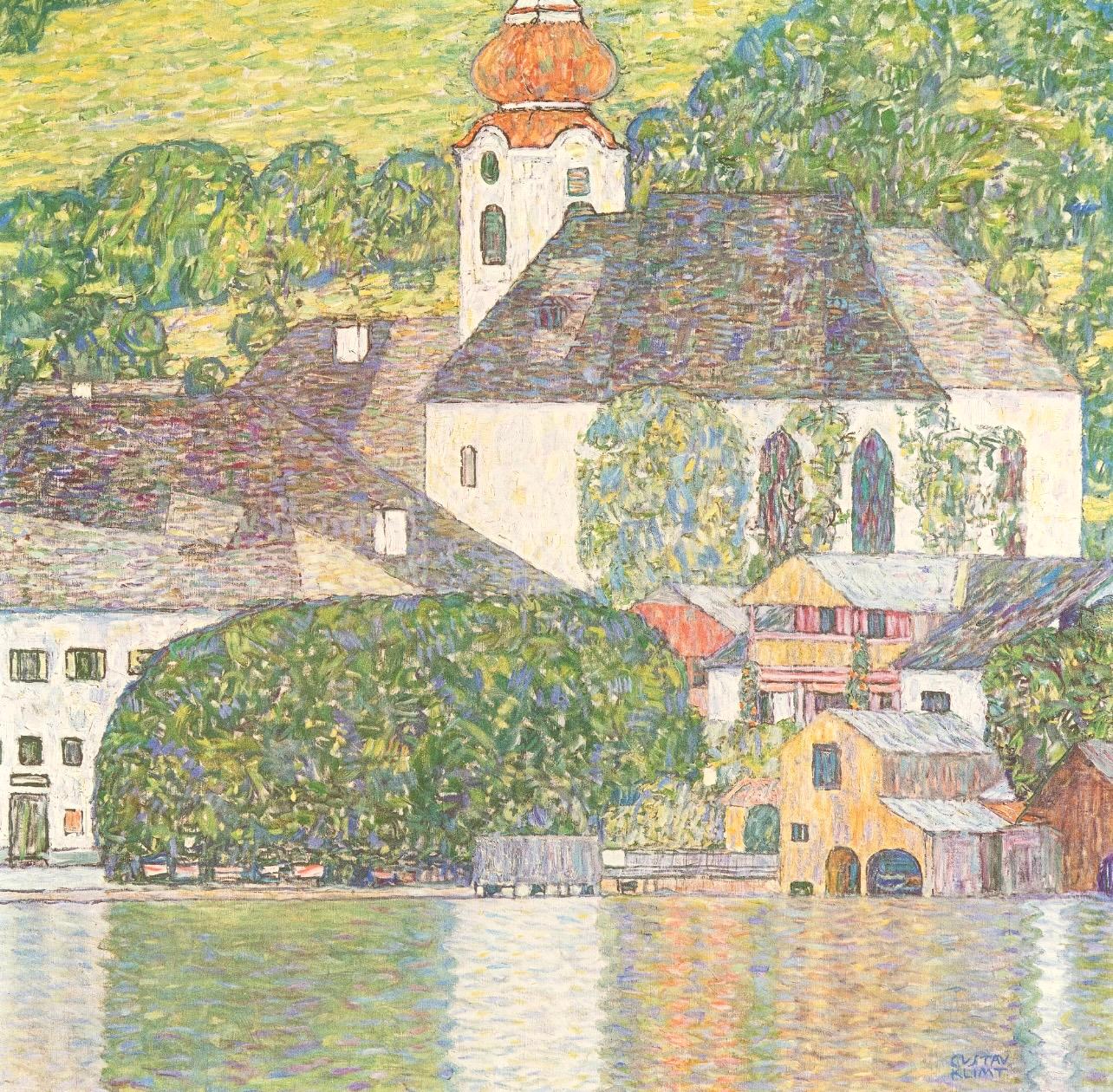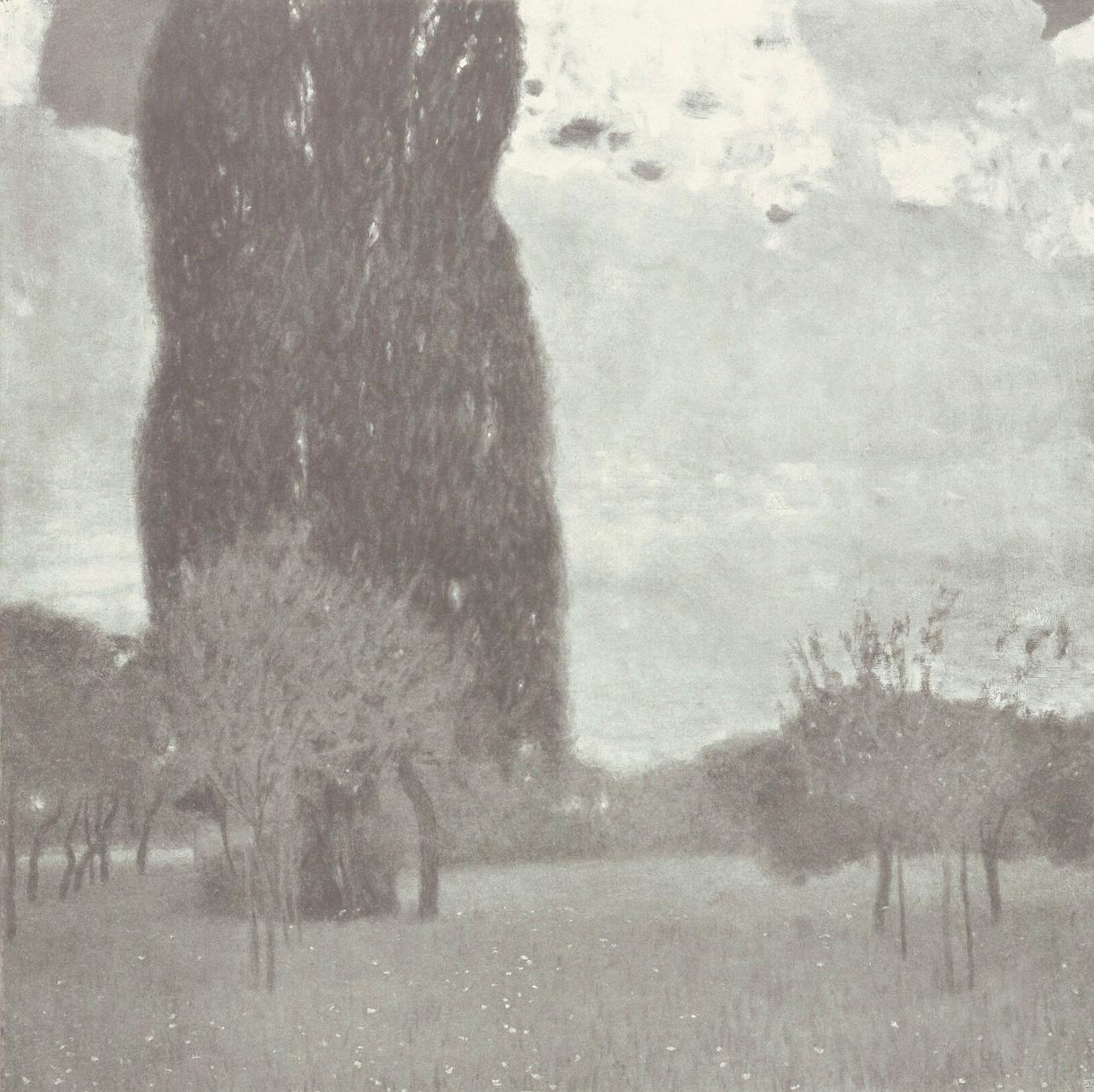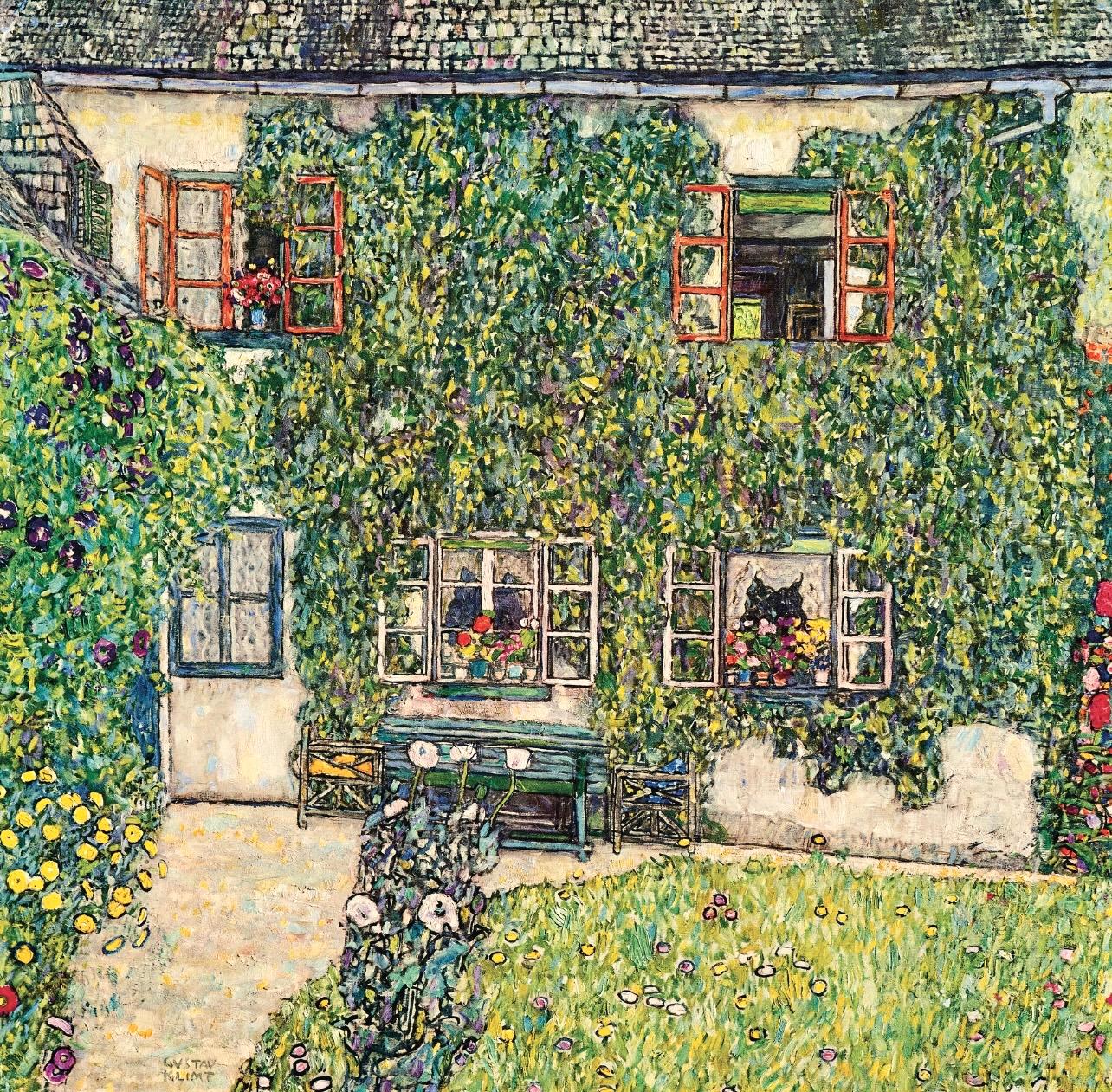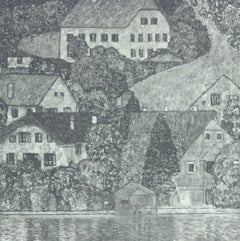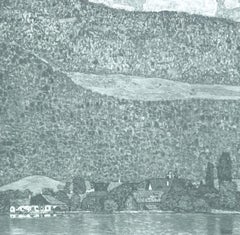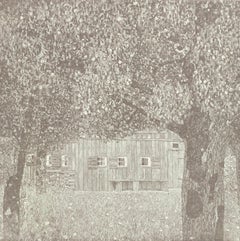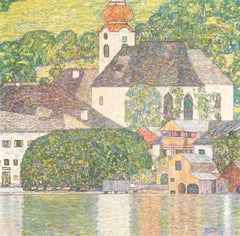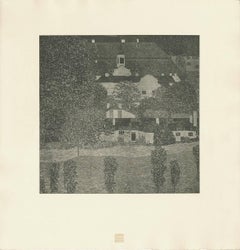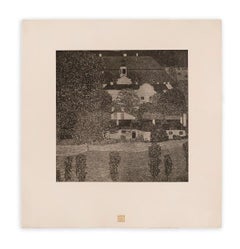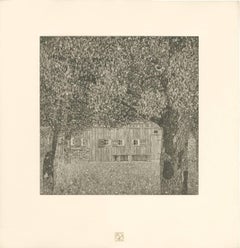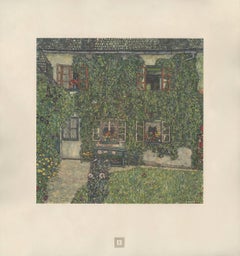Items Similar to Klimt, Schloss Kammer am Attersee, Das Werk von Gustav Klimt (after)
Want more images or videos?
Request additional images or videos from the seller
1 of 11
Klimt, Schloss Kammer am Attersee, Das Werk von Gustav Klimt (after)1918
1918
$23,996
$29,99520% Off
£17,851.07
£22,313.8420% Off
€20,928.99
€26,161.2420% Off
CA$33,561.45
CA$41,951.8220% Off
A$37,472.34
A$46,840.4220% Off
CHF 19,661.34
CHF 24,576.6720% Off
MX$462,474.96
MX$578,093.6920% Off
NOK 247,145.55
NOK 308,931.9420% Off
SEK 231,248.49
SEK 289,060.6220% Off
DKK 156,133.83
DKK 195,167.2820% Off
Shipping
Retrieving quote...The 1stDibs Promise:
Authenticity Guarantee,
Money-Back Guarantee,
24-Hour Cancellation
About the Item
Héliogravure, collotype vélin paper. Paper Size: 18.23 x 17.32 inches; image size: 11.77 x 11.85 inches. Inscription: Signed in the plate and unnumbered, as issued. Notes: From the folio, Das Werk von Gustav Klimt, 1918. Published by Kunstverlag Hugo Heller & Cie, Wien and Leipzig; printed by kaiserlich-königliche Hof-und Staatsdruckerei, Wien-Landstraße, 1918. Excerpted from the folio, This work was printed in a one-time numbered edition of CCC examples by the kaiserlich-königliche Hof-und Staatsdruckerei, Wien-Landstraße in héliogravure and collotype printing, under the supervision of the artist. The folio is manufactured by the bookbinder Julius Dratwa in Vienna. Examples I to XXXV were attached an original hand drawing by Gustav Klimt. In these examples, the colophon and the X colored sheets are signed with the printed signature of the artist. In the examples XXXVI to LXX, only the title page with the printed signature of the artist. The other examples carry the numbering I to CCXXX. Additional Notes: Klimt's only monograph published in his lifetime and shortly before his death. Prepared and produced under his artistic supervision between 1908 and 1918, Das Werk was a collaboration between the artist and his close friend, the Viennese publisher, Hugo Heller. Each image is rendered in héliogravure and collotype and bears its distinctive signet in the lower margin. These gold signets were original designs which Klimt specifically developed between 1908 and 1914 in order to designate and symbolize each image in this portfolio (for further information on the signets and their relationship to the paintings, see Alice Strobl, Die Zeichnungen 1904-1912, Salzburg, 1982, pages 286-290.) The total edition was LXX deluxe examples, with an original drawing, and an edition of CCXXX, though many were lost or misplaced as a result of Heller's bankruptcy, subsequent move, and Klimt's death soon after the publication. The Emperor Franz Joseph was the first to buy an example of the portfolio and, notably, Frank Lloyd Wright owned one as well (See Alofsin, Anthony. Frank Lloyd Wright, Art Collector: Secessionist Prints from the Turn of the Century. 2012).
GUATAV KLIMT (1862-1918) was an Austrian symbolist painter and a founding member of the Vienna Secession movement. His work helped define the Art Nouveau in Europe. Klimt is noted for his paintings, murals, sketches, and other objets d'art. Klimt's primary subject was the female body, and his works are marked by a frank eroticism. Amongst his figurative works, which include allegories and portraits, he painted landscapes. He is best known for The Kiss and Portrait of Adele Bloch-Bauer I. Among the artists of the Vienna Secession, Klimt was the most influenced by Japanese art and its methods. Early in his career, he was a successful painter of architectural decorations in a conventional manner. As he began to develop a more personal style, his work was the subject of controversy that culminated when the paintings he completed around 1900 for the ceiling of the Great Hall of the University of Vienna were criticized as pornographic. He subsequently accepted no more public commissions, but achieved a new success with the paintings of his "golden phase", many of which include gold leaf. Klimt's work was an important influence on his younger peer Egon Schiele. Klimt's final painting, Dame mit Fächer, 1918, was sold by Sotheby's in London on 27 June 2023 for 108.4 million USD to a Hong Kong collector—the highest-priced artwork ever sold at auction in Europe.
- Creation Year:1918
- Dimensions:Height: 18.23 in (46.31 cm)Width: 17.32 in (44 cm)
- Medium:
- Movement & Style:
- After:Gustav Klimt (1862 - 1918, Austrian)
- Period:
- Condition:
- Gallery Location:Auburn Hills, MI
- Reference Number:1stDibs: LU1465216184092
About the Seller
4.9
Platinum Seller
Premium sellers with a 4.7+ rating and 24-hour response times
Established in 1978
1stDibs seller since 2021
1,125 sales on 1stDibs
Typical response time: <1 hour
- ShippingRetrieving quote...Shipping from: Auburn Hills, MI
- Return Policy
Authenticity Guarantee
In the unlikely event there’s an issue with an item’s authenticity, contact us within 1 year for a full refund. DetailsMoney-Back Guarantee
If your item is not as described, is damaged in transit, or does not arrive, contact us within 7 days for a full refund. Details24-Hour Cancellation
You have a 24-hour grace period in which to reconsider your purchase, with no questions asked.Vetted Professional Sellers
Our world-class sellers must adhere to strict standards for service and quality, maintaining the integrity of our listings.Price-Match Guarantee
If you find that a seller listed the same item for a lower price elsewhere, we’ll match it.Trusted Global Delivery
Our best-in-class carrier network provides specialized shipping options worldwide, including custom delivery.More From This Seller
View AllKlimt, Am Attersee, Gustav Klimt, Eine Nachlese (after)
By Gustav Klimt
Located in Auburn Hills, MI
Héliogravure, collotype vélin paper. Paper Size: 18.86 x 17.91 inches; image size: 12.09 x 11.89 inches. Inscription: Signed in the plate and unnumbered, as issued. Notes: From the f...
Category
1930s Symbolist Figurative Prints
Materials
Lithograph
$15,996 Sale Price
20% Off
Klimt, Unterach am Attersee, Gustav Klimt, Eine Nachlese (after)
By Gustav Klimt
Located in Auburn Hills, MI
Héliogravure, collotype vélin paper. Paper Size: 18.86 x 17.91 inches; image size: 11.89 x 12.01 inches. Inscription: Signed in the plate and unnumbered, as issued. Notes: From the f...
Category
1930s Symbolist Figurative Prints
Materials
Lithograph
$15,996 Sale Price
20% Off
Klimt, Oberösterreichisches Bauernhaus, Das Werk von Gustav Klimt (after)
By Gustav Klimt
Located in Auburn Hills, MI
Héliogravure, collotype vélin paper. Paper Size: 18.23 x 17.32 inches; image size: 11.89 x 11.85 inches. Inscription: Signed in the plate and unnumbered, as issued. Notes: From the f...
Category
1910s Symbolist Figurative Prints
Materials
Lithograph
$23,996 Sale Price
20% Off
Klimt, Kirche am Wolfgangsee, Gustav Klimt, Eine Nachlese (after)
By Gustav Klimt
Located in Auburn Hills, MI
Héliogravure, collotype, metallic inks on vélin paper. Paper Size: 18.86 x 17.91 inches; image size: 12.01 x 12.09 inches. Inscription: Signed in the plate and unnumbered, as issued....
Category
1930s Symbolist Figurative Prints
Materials
Lithograph
$19,996 Sale Price
20% Off
Klimt, Die hohe Pappel, Das Werk von Gustav Klimt (after)
By Gustav Klimt
Located in Auburn Hills, MI
Héliogravure, collotype vélin paper. Paper Size: 18.23 x 17.32 inches; image size: 11.81 x 11.69 inches. Inscription: Signed in the plate and unnumbered, as issued. Notes: From the f...
Category
1910s Symbolist Figurative Prints
Materials
Lithograph
$23,996 Sale Price
20% Off
Klimt, Haus im Garten, Gustav Klimt, Eine Nachlese (after)
By Gustav Klimt
Located in Auburn Hills, MI
Héliogravure, collotype, metallic inks on vélin paper. Paper Size: 18.86 x 17.91 inches; image size: 12.13 x 12.24 inches. Inscription: Signed in the plate and unnumbered, as issued....
Category
1930s Symbolist Figurative Prints
Materials
Lithograph
$19,996 Sale Price
20% Off
You May Also Like
H.O. Miethke Das Werk folio "Schloss Kammer on Lake Attarsee II" collotype print
By Gustav Klimt & K.K. Hof-und Staatsdruckerei
Located in Chicago, IL
DAS WERK GUSTAV KLIMTS, a portfolio of 50 prints, ten of which are multicolor collotypes on chine colle paper laid down on hand-made heavy cream wove paper with deckled edges; under each of the 50 prints is a gold signet intaglio printed on the cream paper each of which Klimt designed for the publication as unique and relating to its corresponding image; H.O. Miethke, Editor-Publisher; k.k. Hof-und Staatsdruckerei, Printer; printed in a limited edition of 300 numbered plus several presentation copies; Vienna, 1908-1914.
The idea of collaboration in the arts is anything but new; however it has so often been viewed and assessed as somehow devaluing the intrinsic worth of art. It’s as if it was a dirty secret to be hidden away. More so even than the eroticism explored by Klimt, which divided public opinion, the artistic avant-garde began to boldly flaunt artistic collaboration beginning in the 19th century- which gained steam in the first part of the 20th century- to become a driving vehicle of contemporary artistic creation. Viewed in this context, the folios of collotype prints published by H.O. Miethke in Vienna between 1908-1914 known as Das Werk Gustav Klimts, are important art documents worthy of as much consideration for their bold stand they take on established ways of thinking about artistic collaboration as they are for their breathtakingly striking images.
1908 is indeed a watershed moment in the history of art. To coincide with the 60th anniversary of the reign of Emperor Franz Joseph I, Kunstschau opened in Vienna in May of that year. It was there that Klimt delivered the inaugural speech. Speaking about the avant-garde group’s unifying philosophy of Gesamtkunstwerk, or the synthesis of the arts, Klimt shared his belief that the ideal means to bring artists and an audience together was via “work on major art projects.” It was at Kunstschau 1908 that Klimt first exhibited his most iconic painting, The Kiss, as well as The Sunflower, Water Snakes I and II and Danae. It was at Kunstschau 1908 that Das Werk Gustav Klimts was first available for purchase. Thanks to Galerie Miethke’s organization, Kunstschau 1908 was possible. Miethke’s pioneering art house had become Klimt’s exclusive art dealer and main promoter of his modernist vision. Paul Bacher and Carl Moll, a founding member with Klimt of the Vienna Secession, who all broke away during the rift in 1905, took stewardship of the gallery following the fallout with the Secession. Das Werk Gustav Klimts is a prime example of Miethke’s masterful and revolutionary approach to marketing art. Miethke’s innovative marketing strategy played to a penchant for exclusivity. The art gallery and publishing house utilized the press and art critics- such as Austria’s preeminent Art Historian, Hugo Haberfield, who became Director of the gallery in 1912- as a means of gaining publicity as well as maintaining effective public relations. Miethke used the grand exposition format to extend the art gallery’s market reach, cultivating their product’s prestige by stroking the egos of current art patrons while simultaneously creating accessibility for newcomers and others avid collectors to share a relative proximity to other wealthy and respected members of the art collecting community. Essentially, their approach paved the way for what is still the predominant means of marketing.
Between 1908 and 1914, H.O. Miethke published a total of 5 installments of print folios of Klimt’s painted work, each comprising 10 prints. The series was limited in availability to 300 and purchase was arranged through subscription. Each issue was presented unbound in a gold embossed black paper folder. Included in the folio was a Title Page, a Justification page and a Table of Contents page itemizing each of the 10 printed works with details about their corresponding painted works as well as information about each work’s current owner. These folios were not comprehensive of Klimt’s work; but rather, they feature what he believed were his most important paintings from 1898-1913. Only 2 collotypes in each folio were multicolored.
To punctuate the fact that Klimt, himself, was very much an active player in creating these printed works, he created square-shaped signets, unique to each collotype which were intaglio printed in gold ink at the bottom of the cream wove papers to which the chine collie papers were affixed.These signets relate thematically to their corresponding printed images and designate each of those images by their placement in the folio’s Table...
Category
Early 1900s Vienna Secession Landscape Prints
Materials
Paper
Schloss Kammer Lake Attersee II by Gustav Klimt, Das Werk collotype, 1908-1912
By Gustav Klimt
Located in Chicago, IL
Original collotype created from Gustav Klimt’s Schloss Kammer on Lake Attersee II (Das Werk Gustav Klimts), originally painted in 1909. Publishe...
Category
Early 1900s Vienna Secession Prints and Multiples
Materials
Paper
H.O. Miethke Das Werk folio "Farm House in Buchberg" collotype print
By Gustav Klimt & K.K. Hof-und Staatsdruckerei
Located in Chicago, IL
DAS WERK GUSTAV KLIMTS, a portfolio of 50 prints, ten of which are multicolor collotypes on chine colle paper laid down on hand-made heavy cream wove paper with deckled edges; under each of the 50 prints is a gold signet intaglio printed on the cream paper each of which Klimt designed for the publication as unique and relating to its corresponding image; H.O. Miethke, Editor-Publisher; k.k. Hof-und Staatsdruckerei, Printer; printed in a limited edition of 300 numbered plus several presentation copies; Vienna, 1908-1914.
The idea of collaboration in the arts is anything but new; however it has so often been viewed and assessed as somehow devaluing the intrinsic worth of art. It’s as if it was a dirty secret to be hidden away. More so even than the eroticism explored by Klimt, which divided public opinion, the artistic avant-garde began to boldly flaunt artistic collaboration beginning in the 19th century- which gained steam in the first part of the 20th century- to become a driving vehicle of contemporary artistic creation. Viewed in this context, the folios of collotype prints published by H.O. Miethke in Vienna between 1908-1914 known as Das Werk Gustav Klimts, are important art documents worthy of as much consideration for their bold stand they take on established ways of thinking about artistic collaboration as they are for their breathtakingly striking images.
1908 is indeed a watershed moment in the history of art. To coincide with the 60th anniversary of the reign of Emperor Franz Joseph I, Kunstschau opened in Vienna in May of that year. It was there that Klimt delivered the inaugural speech. Speaking about the avant-garde group’s unifying philosophy of Gesamtkunstwerk, or the synthesis of the arts, Klimt shared his belief that the ideal means to bring artists and an audience together was via “work on major art projects.” It was at Kunstschau 1908 that Klimt first exhibited his most iconic painting, The Kiss, as well as The Sunflower, Water Snakes I and II and Danae. It was at Kunstschau 1908 that Das Werk Gustav Klimts was first available for purchase. Thanks to Galerie Miethke’s organization, Kunstschau 1908 was possible. Miethke’s pioneering art...
Category
Early 1900s Vienna Secession Landscape Prints
Materials
Paper
Max Eisler Eine Nachlese folio “House in a Garden” collotype print
By (after) Gustav Klimt
Located in Chicago, IL
After Gustav Klimt, Max Eisler #9, Haus Im Garten; aka Forester’s House in Weissenbach II; multi-color collotype after 1914 painting in oil on canvas.
GUSTAV KLIMT EINE NACHLESE (GU...
Category
1930s Vienna Secession Landscape Prints
Materials
Paper
Diex, Carinthia, Austria
By Josef Eidenberger
Located in San Francisco, CA
This artwork titled "Diex, Carinthia, Austria" c.1950 is a color etching on Wove paper by noted Austrian artist Josef Eidenberger, 1899-1991. It is hand signed in pencil by the artist. Published/printed by Graphics International, Austria. The plate mark (image) size is 13.75 x 10.75 inches, sheet size is 20.5 x 16.15 inches. It is in excellent condition, has never been framed.
About the artist.
Josef Eidenberger was born in 1899 in the little town of Goisern, Austria,he began his artistic career as a landscape painter. In 1923 he enrolled in the famed Graphic Academy of Art in Vienna and studied under Professor Alfred Cossman.
His recognized talent brought him many commissions from city officials and members of the business communities throughout Europe, especially in Austria and Germany. In 1973 after visiting the United States for the first time he created a series of California etchings...
Category
Mid-20th Century Realist Figurative Prints
Materials
Etching
Kirchdorf Oberndorf - Marktes Röhrnbach 2020, Painting, Oil on Canvas
Located in Yardley, PA
Painted during a family visit to Bavaria, the Bavarian landscape is simply magnificent. I am happy every time I visit and get the opportunity to paint between family obligations. Si...
Category
2010s Impressionist Paintings
Materials
Oil
